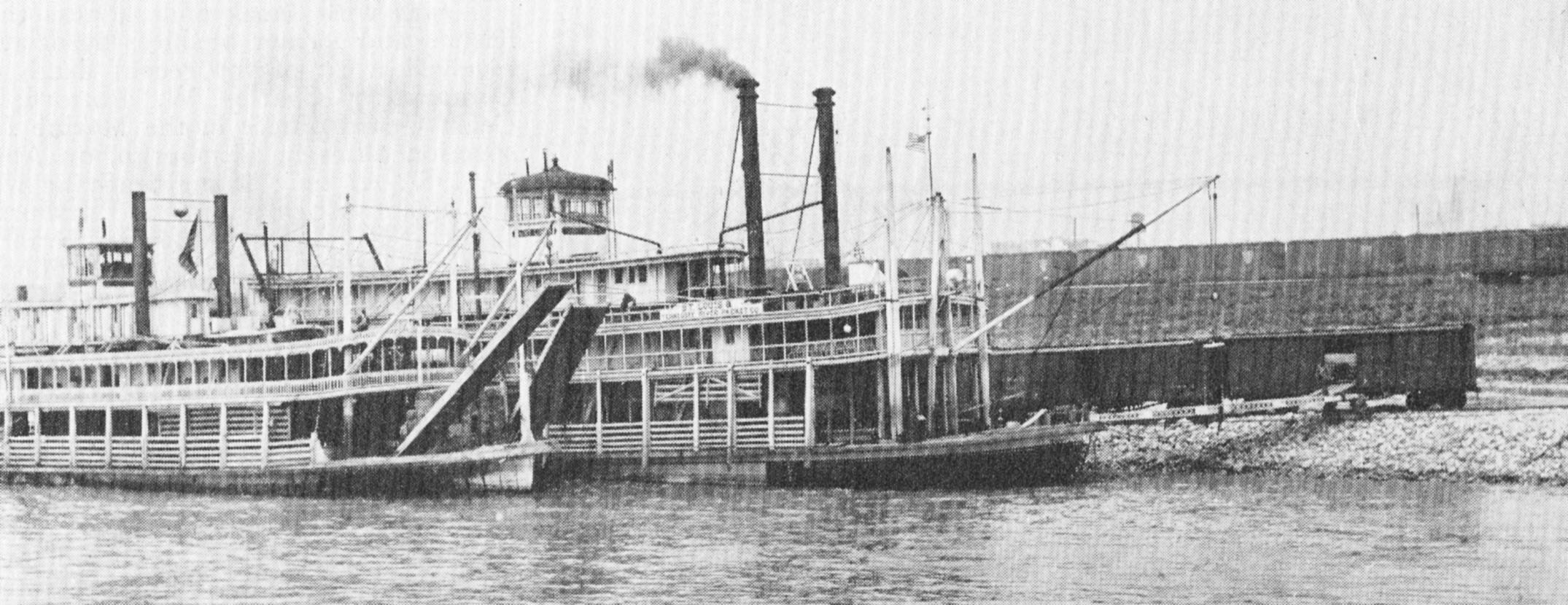This week, the Old Boat Column presents an unusual image. The packets Bald Eagle (left) and Saint Louis are engaged in the transfer of freight at a St. Louis railroad incline. It was at this landing that various packet boats from the Tennessee River routinely reshipped their cargo by rail.
The Bald Eagle
The Bald Eagle was built at Madison, Ind., in 1898 on a wooden hull measuring 206.5 feet in length by 34.2 feet in width. Two boilers supplied steam to engines having 15-inch cylinders with a 5-foot stroke.
The sternwheeler contained much equipment from the D.H. Pike, built in 1883 and dismantled in 1898.
Owned by the Eagle Packet Company, headquartered at St. Louis, the boat carried the customary gold ball between the smokestacks; this was the well-known insignia of the line.
The riverboat ran mostly in the St. Louis–Illinois River trade, operating until 1929. After retirement, the Bald Eagle was used as a quarterboat on the Missouri River; it sank and the hull broke in half in 1934.
The Saint Louis
A stellar product of the Howard Shipyard & Dock Company at Jeffersonville, Ind., the sternwheeler Saint Louis was constructed in 1912 for a contract cost of $21,950.
Although much consideration was given to building the new boat with a steel hull, the decision was made in favor of a wooden hull that measured 210 feet in length by 38 feet in width. The completion of the vessel came too late in the 1912 season to enter the St. Louis–Tennessee River trade, so the brand new riverboat was taken, for safety from ice, to the Duck’s Nest at Paducah. Capt. Harry Crane was in command when the boat departed from the Howard Shipyard. Other crew members included Capt. Dan Kane, pilot; Ed Latham and James St. John, engineers; Harry Rogers, mate; Charles Jefferson, steward and Frank Sinks, electrician.
In the spring of 1913, the sparkling fresh steamboat entered the St. Louis and Tennessee River trade under the command of Capt. Frank Gill. Presiding in the pilothouse were Capt. Theodore Hall and Capt. Harry Crane; Harry Rogers and Bernard Carragher were the mates. Al Gambeck was in charge of the bar; several decades later he was still working on the river aboard the Greene Line tourist steamer Delta Queen.
The Saint Louis was reportedly the finest riverboat ever owned by the St. Louis & Tennessee River Packet Company, having many amenities not found on other steamboats of the time. The cabin was 150 feet in length by 12 feet wide and contained 60 staterooms which could accommodate 120 passengers.
Slightly more than a century ago, shortly after midnight on September 2, 1918, the boat struck an underwater obstruction while upbound on the Mississippi River at Sulphur Springs, Mo., some 22 miles below St. Louis. The boat settled in 25 feet of water; 40 passengers (mostly women and children) were accounted for, but one woman was never found. Divers investigated the wreck and it was decided unworthy of salvage. Capt. John Massengale, president of the famous firm, estimated the loss at $50,000.
Editor’s note: For questions or suggestions regarding the Old Boat Column, Keith Norrington may be contacted by e-mail at curatorkeith@yahoo.com, or by mail through the Howard Steamboat Museum at P.O. Box 606, Jeffersonville, Ind. 47131-0606.
Caption for photo: The steamers Bald Eagle and Saint Louis offloading freight into railroad cars at St. Louis. (Keith Norrington collection)




